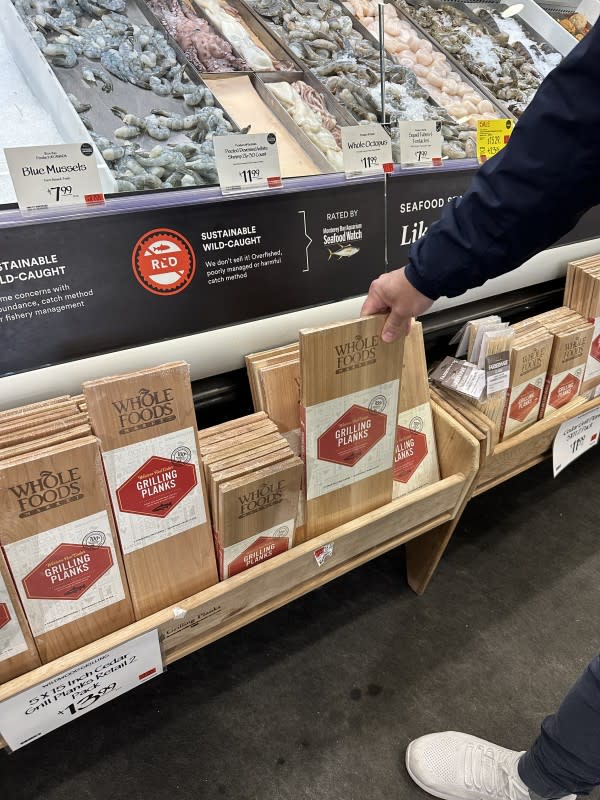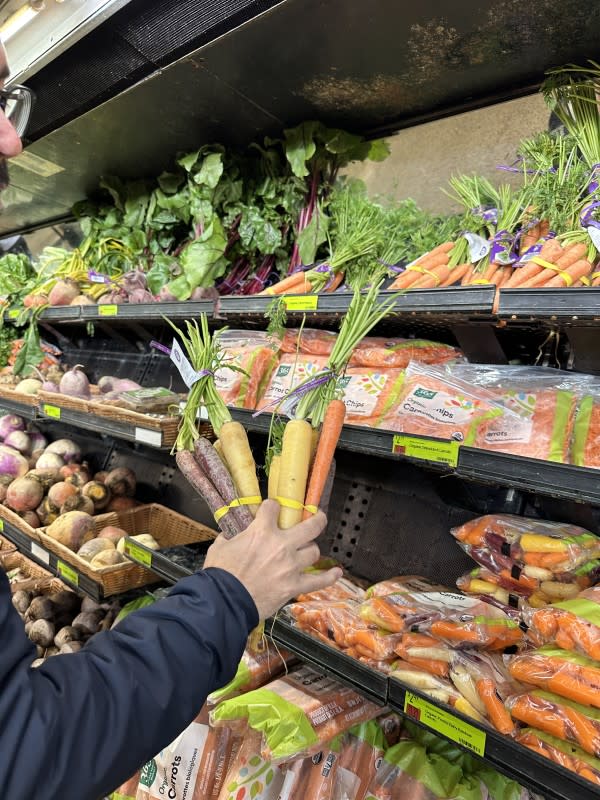I Went to Whole Foods With My Chef-Husband and My Grocery Shopping is Forever Changed

Chef Luke scouring the seafood section at Whole Foods in search of dinner
The first time I went to a grocery store with my chef-husband, Luke, I was in heaven. I've always loved grocery stores: Trader Joe's, Fairway, Citrarella...even Costco was cool to me. Growing up, my parents never shopped there so anytime I knew a card-carrying member of the buy-in-bulk warehouse was heading over, I offered to tag along.
My first grocery store trip with Luke wasn't to Costco but to Whole Foods, where we still shop together today. If there's no small organic market nearby or specialty foods store, Whole Foods it is for Luke.
Luke loves Whole Foods because it's reliable, reasonable (according to him; he is a classically French-trained chef after all), high quality and most importantly, well mapped out. "As a general rule of thumb, you want to stay outside of the inside rows," he told me on that first shopping trip while looking over a handful of heirloom tomatoes with a discerning eye. "Inside rows are more processed, shelf-stable foods; the outside rows are where the seasonal, fresh, best produce lives."
Noted, I thought, as I watched him skillfully select stone fruit next. Everything was sensorial based: he would touch, smell, and inspect everything closely before deciding whereas my process of elimination had usually been to avoid mushy, moldy ingredients and hope they were the right pick.
Shopping with a chef was like having a free personal assistant with you who knew all the right answers—and having him around has changed how I grocery shop for the better. Here's what I've learned along the way. And although our trips to Whole Foods inspired these tips, many of them apply to grocery shopping in general, no matter the store.
Related: My Chef-Husband Made Me the World's Best Breakfast Sandwich and My Mornings Are Forever Changed
Tips for Shopping at Whole Foods According to My Chef-Husband
1. Start in the protein section. "After you get flowers at the front of the store for your wife," Luke jokes. Although I was more tempted by the aromatic blooms flanking the front doors myself, Luke likes to start with the protein section to see what looks good, then builds the rest of the meal around that. But what if you aren't a chef and aren't exactly sure? "The eye test is great, especially when it comes to seafood," he tells me. "Or, ask the staff what’s fresh, what’s in season, what’s wild-caught or what was previously frozen—and avoid the latter."

Kelli Acciardo Venner
2. Be choosy about fish. He says Whole Foods is great about labeling fresh fish that are wild-caught under the names but is also quick to point out that farmed and frozen fish aren't necessarily bad. "There are great sustainable farm programs and there are great frozen seafood options," he says, "but I'm just not a big fan of farmed shrimp or tuna. It sort of depends on the species." Frozen salmon gets Luke's approval, however, when I ask him to choose one that I can use to make salads during the week.

Kelli Acciardo Venner
3. Keep an eye out for useful tools and gadgets. While perusing the fish section, Luke spied a pack of cedar grilling planks and threw those in our cart too. Although he has a professional kitchen and grills at his restaurant, he mentions these are great to have on hand anytime you're in the mood for cedar-plank salmon at home. If you're not sure how to use something like this, quiz the folks at the seafood counter.

Kelli Acciardo Venner
Related: How to Make Grilled Cedar Plank Salmon
4. Look for well-marbled meats. If you're leaning more carnivorous for dinner, Luke shows me how to ID the best meat: by its marbling. "Flecks of white fat and intermuscular marbling in red meat indicate juicy, flavor-packed steaks," he explains. "You can also ask the butcher if they have any specialty prime cuts. Prime cuts usually have the most marbling," he says.

Kelli Acciardo Venner
5. Shop the perimeter of the produce section. After Luke hits the meat and seafood counters, it's on to produce. "At Whole Foods the hyper-seasonal good stuff is usually at the front," he says. During our recent outing in February, we saw a lot of citrus fruits, like dekopon aka "Sumo Citrus" oranges, blood oranges and Meyer lemons.

Kelli Acciardo
6. Opt for bunches of veggies over bagged. I have to admit, pre-Luke, I would usually take the easy way out in the produce aisle by grabbing pre-cut, pre-sliced, pre-spiralized veggies to save me time. Shredding Brussels sprouts by hand is a tedious task after all, so why not just go for the bagged? A huge no-no accordion to my husband. "Always avoid bagged!" he says, grabbing beautiful bunches of rainbow carrots and tossing aside the shredded and pre-cut baby carrots. "They are treated with a gas to preserve them so they stay crisp, which makes them spoil faster. A Ziploc bag of peppers or Meyer lemons is okay, but you don't want gassed."

Kelli Acciardo Venner
7. Check the baskets for gems. After I vow to never buy a bag of shredded cabbage again, we swing by the rows of baskets in the produce section. "Sometimes there are unique things in these baskets like this purple top turnip or watermelon radish," he tells me, eyes aglow as if he's sifting through a pile of loose diamonds. "In-season baskets are where you can get lucky with exotic mushrooms, too."

Kelli Acciardo Venner
8. Be wary of prepared foods. His last bit of wisdom came as he saw me circling the antipasto case. (That's what I call the rows of cooked vegetables, salads and sides that always seem so appealing.) "You have two days max on a cooked vegetable," he warns me, "so you have to be careful. Peppers go bad real quick. Cooked asparagus? One day max. Remember that prepared foods have probably been sitting in the case for a day or two, so unless you plan on eating them right away, you're better off making your own version."
Next: My Chef-Husband Made Me His Marry Me Potatoes and I Would Definitely Say 'I Do' All Over Again